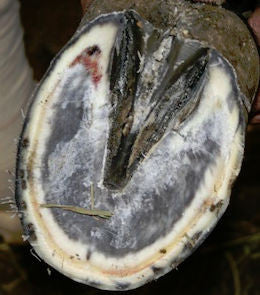
How to Spot and Deal with Bruised Heels
Share
Bruising on the heels of the hoof usually is caused by direct injury from rocks, irregular hard ground with pebbles, stones, etc. or other trauma to the heel. Poor shoeing, especially in horses with flat feet or dropped soles, can increase the risk of bruising. Bruising may or may not be the cause of lameness but if the body does not assimilate the bruise it can lead to further development and complications.
The bruises that occur at the heel buttress are known as "Corns". They are most noticed on the front hooves. Imbalanced hooves, inordinate pressure and heels trimmed to short will often result in 'corns'. Corns can develop easily into abscesses which then need diligent care to remediate.
One can easily spot a bruise on a clean hoof by a pinkish coloring in the horn. Alternatively, veterinarians or farriers may use hoof testers to determine where a bruise is on the hoof.

www.hoofblog.com HOOF BRUISE
Here we can clearly see a red bruise right at the seat of corn area of the medial heel. It actually shows an infected corn. But the pink area illustrates what a bruised heel can look like. Less severe bruising can be a bit more difficult to spot as it may just appear as a light pink area. So one needs to be vigilant when cleaning and inspecting the hooves.
On the photo of the following hoof I've outlined the bruised area of the hoof ... simply so you can see what 'bruising' looks like. "The pinkish color in the sole is caused by too much pressure from snow- and ice packing. It is definitely bruising, but horses never seem to be bothered by it. By the time this color appears, the insult has been about 3 month prior."

Photo courtesy of Heike Bean
If your horse has 'little' to 'no heel' then you can expect to find bruising on the buttresses as the heels begin to grow out. Treatment involves simple time as long as there are no other complications. Throw on those boots and go riding! No other treatment is required for a simple bruise.
More complicated bruises will require the attention of your veterinarian or hoof care person. Treatment may include soaking, wrapping and hoof protection until the situation is resolved.
Here we see a healthy hoof, freshly trimmed, with no evidence of heel bruising at all:

Photo - thehorseshoof.com
Prevention is the best way to avoid bruising of the heels with good diet, proper hoof care that leaves heels at their proper height, strong immune system and that "M" word we talked about in the very first blog post -- movement. The more the horse moves the more circulation gets into the hooves, the faster rate of growth, the more oxygen and nutrients get to the hooves through the blood ... and the healthier and stronger the hooves become.
Remember -- the hooves are part of the whole horse. So, even with simple bruising of the heels, think of the "whole" horse when determining the course of action to take for the insult to the hooves.
The team at Scoot Boot believe passionately in the barefoot horse and strive to build a supportive community of barefoot horse lovers.
Find more information about using Scoot Boots here.

Gwenyth Santagate is the author of "10 Secrets to Healthy Hooves" . For the last 37+ years, she has maintained healthy hooves with natural trimming on thousands of horses and specialized in pathological rehabilitation hoofcare for the last 18 years. She keeps a small herd of her own equine continues to offer consults for horses in need.

